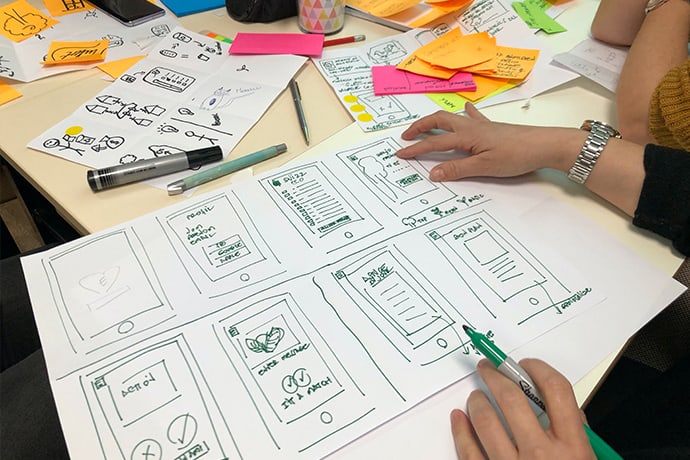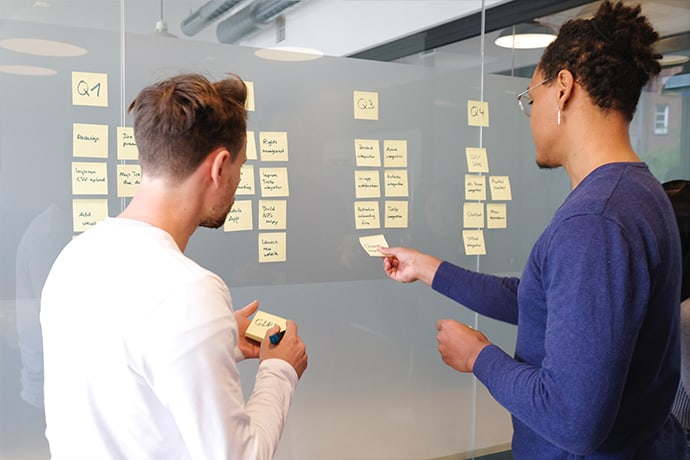 SPEAKERS
SPEAKERS
 TOPICS
TOPICS
The design thinking methodology approaches real world problems with a solution-based approach. Learn more about the design thinking process examples and how they can be applied at your organisation.

Solving a complex problem can be a challenging task at times. However, by taking the right approach to solving it, you can break down a task into smaller manageable chunks. This is known as agile methodology. Reframing a problem like this isn’t uncommon, but approaching it in a non-linear iterative process is typically what defines design thinking.
Design thinking theory can essentially be applied to many different contexts. Design thinking framework is based on tackling complex problems by using human-centric solutions. It’s typically used when the problem is hard to quantify with human means. By breaking it down into something more manageable and understandable by regular people, design thinking can greatly simplify a task and give you a deeper understanding of user needs.
Like other methodologies that are designed to solve problems, design thinking is broken down into smaller steps that are easier to understand and follow. Design thinking stages are:
These are also generally recognised as Stanford Design thinking processes. These five stages of design thinking are typically carried out in this order, with each step serving a vital role in helping you not just understand the problem, but also tackle it swiftly.
The first stage, empathy, involves researching end user needs and getting a better understanding of pain points. If there’s a complex problem that doesn’t have obvious solutions, then a smart first step to take would be understanding why something is a problem in the first place. This helps you gain a better understanding of the troubles or difficulties that your users are having.
This sounds like an obvious step to take, but many user experience developers neglect it. In fact, it’s fairly common to have assumptions as a UX designer which make it hard for you to be empathetic with your users. This is because a UX developer tends to work on the design of something for many weeks, months, or even years, thus gaining intimate familiarity with it.
As a result, they often don’t experience the same gripes or challenges in using something that an average user would, hence the disconnect.
This is why empathy is such an important consideration in problem-solving. The design thinking process highlights this as one of the first steps to take when adopting a design thinking methodology. To understand your users is to understand the problem at hand, and this ultimately paves the way to tackling a difficult problem.
The goal here is to gain an intimate understanding of the perceived problem. This is an information gathering stage and should result in lots of opinions and data that can be used to better understand the difficulties that users are facing.
The define stage is used to categorise and organise the information that you’ve gathered from stage one. It’s fairly common for a group using the design thinking methodology to rethink their problems at this stage, often as a result of the information that was collected. If you’ve reached a different conclusion to your initial hypothesis or the perceived problem, then it can actually uncover greater underlying issues that need to be solved sooner rather than later.
An important step here is to define a problem from the user’s perspective and not your own. For instance, a problem shouldn’t be framed as “we need to get more users to use this feature on our app.” Instead, the problem statement should be closer to “why are users not interested in using this feature?”. This puts the issue into perspective, giving you an idea of what it’s like as a user and what difficulties or problems they might face.
The goal of this stage is to organise all of the information that was obtained in the first stage. You don’t necessarily have to act on it, but you do need to clearly identify the challenges that you are facing. The design thinking model is great for collecting insightful data on your users, but it’s up to you and your team to categorise those opinions and data in order to turn them into something useful and actionable.
The ideation phase focuses on using the categorised and organised information from stage two to generate creative ideas that could potentially solve the problem. This is the main body of the design thinking methodology and is where a large portion of your time will be spent. Once you’ve reached ideation stage, you and your team should have a deep understanding of your users, their problems, and also what their experiences are like. With this solid foundation, you should have plenty of information to start developing innovative solutions.
There are a number of ideation methodologies that can be used to kickstart this stage. Here are just a couple:
These ideation methods should result in many promising solutions to your UX challenges.
By the end of stage three, you should aim to have several possible solutions for your initial problem. Most, if not all of the information from stages one and two should be utilised, and you should have several working ideas for how to solve it.
The prototyping stage takes the ideas generated in the previous stage and transforms them into practical solutions that can be tested. This can be carried out in a number of different ways, and the optimal process here will really depend on what kind of products or services you offer and how you plan to tackle the problem.
For instance, if your initial problem was that people aren’t using your business’s app enough. Then the prototyping stage should feature some examples of new features and interface designs that could appeal to your audience. Or, you could end up creating scaled-down versions of a product or service for testing purposes.
To make this stage go smoothly, it’s important to generate detailed and informative ideation records that serve as a base for your prototypes.
Since this is an experimental process, the goal here is to find a working prototype that provides a solution to the original problem detailed in the first two stages. It’s important to reference those records to ensure that you’re on the right path to solving the challenges that kickstarted the design thinking process.

And finally, the last phase of the design thinking methodology is to put your solutions to the test. Solutions should be rigorously tested to ensure that they both solve the problem outlined in earlier stages, but also show promise as long-term solutions and not temporary fixes.
If possible, real users should be included in the testing phase and you should record their feedback and experiences. This additional data can provide more insights into how your users interact with your designs and how they can be further improved. Prototyping and testing are the two penultimate stages before you assess the outcome, objectively.
But the design thinking process doesn’t end here. Remember that it’s an iterative process that is typically repeated several times until you believe you’ve gained a deep understanding of your users and how they interact with your designs.
While these stages may outline a linear process, it’s important to remember that design thinking is actually non-linear and can be handled by multiple teams at the same time if necessary. For instance, the research stages (empathy and define) could be carried out by a specialised team while a separate design team generates ideas based on the incoming data.
By feeding a constant stream of up-to-date information on users, those ideation processes can naturally evolve and improve over time, leading to an agile design thinking methodology that can simplify and tackle even the toughest UX challenges.
There are numerous case studies and brands that are a testament to the power of applying design thinking and agile principles. Take PayPal, AirBnb, Uber, Nest or Deliveroo, these are disruptor brands that understand, simplify and solve problems.
You don't have to be a design company to implement design thinking principles to your business. All of your offering, whether they are physical products or experiences or intangible assets, could do with an outside eye. Supercar scientist Ella Podmore MBE, Tim Brown, Pinar seyhan Demirdag, Tony Fadell, Adam Cheyer and Guy KAwasaki are some of the most brilliant design thinking keynote speakers ready to guide your teams to think outside of the box. The box by the way may not be a rectangle!